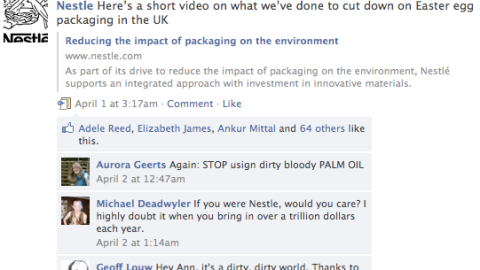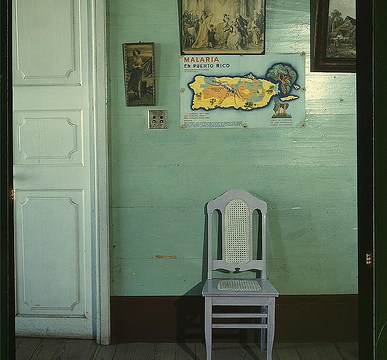Spinning the Web

Nestle has been forced to change its environmentally-destructive business practices after a social media coup; what can netroots activists learn from the victory?
After it was revealed that the Swiss food giant sourced its palm oil through Sinar Mas—a company whose operations contribute to the destruction of the Indonesian rain forest—Greenpeace produced a video comparing eating a Kit Kat bar to eating an orangutan. The video certainly makes its point with graphic imagery, but such shock campaigns don’t always translate into tangible action. Nestle really started to feel the heat, however, when they ordered the video taken down from YouTube for copyright infringement. Then Greenpeace sent out their call to action: supporters sent emails, made phone calls, and, most importantly, posted angry comments on Nestle’s own Facebook page. I say “most importantly” because, unlike emails and phone calls, the Facebook comments didn’t just reach the company, they were public for anyone to see. Nestle’s PR department only made matters worse by responding rudely to aggressive commenters and also by trying to delete certain comments. Anyone who has tried to moderate a website’s comments section knows that nothing can deter some users from posting.
Eventually, the criticism became too much, and Nestle announced Monday that it has begun a new partnership with The Forest Trust to ensure that all their palm oil comes from sources practicing sustainable forestry. As the Guardian points out, this kind of partnership is a first for the palm oil industry, so kudos to Greenpeace.
But how applicable are this battle’s lessons to Facebook and web activism in general? As Jeremiah Owyang points out over at Forbes, the need to develop a presence online means that “many companies jump into social marketing before they are ready,” leaving themselves open to very public criticisms if their brand falls out of favor with the public. Owyang’s overall point is a cynical one, in that it sees in Nestle’s unmasking a failure of public relations rather than a success of consumer pressure, but because of this his article emphasizes the fact that a more media-savvy PR department might have been able to spin the Sinar Mas connection into a non-event.
BP seems to have pulled off something of the sort as their rig continues to pour oil into the Gulf of Mexico. They are pretty much ignoring their main Facebook page and instead focusing their web efforts on a collaborative website, Deepwater Horizon Response. As Caitlin McDevitt writes at The Big Money, “The name and collaborative nature of the page is going to discourage people from posting negative comments about BP. And the company can still use it as a platform to tout BP’s coordination of volunteer activities.” The best spin makes it seem that nothing’s being spun. Someone should tell that to Tony Hayward, BP’s CEO, the next time he starts trying to convince the world how “tiny” his company’s latest environmental disaster really is.





